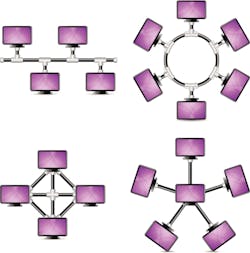For the past several years, industrial networking terms have been the number one source of traffic to the Automation World site. This is not surprising considering that the network has effectively become the center of industrial control as operations become digitized for remote access, data aggregation and analysis, and greater system interoperability.
So, when Automation World readers responded to our survey asking what automation technology questions they would like to have answered, it was no surprise that a number of these questions revolved around networking. We selected one of the more basic, but nevertheless important, network-related questions we received as the topic for episode two in our new podcast series, “Automation World Gets Your Questions Answered.” Specifically, the question we received was: Can you explain the different industrial network topology types?
Understanding network topologies is important to ensure your network is not only operating the way you want it to, but is also structured in a way that allows for flexibility in the face of change and future growth.
For this podcast, we spoke with Michael Bowne, executive director for PI North America, a part of the Profibus/Profinet International organization. In our discussion, Bowne explains the different topology types—such as line, ring, star, and tree—and how they apply to both industrial fieldbus and Ethernet and wireless networks. According to Bowne, “The line topology is most often used in fieldbus due to the one-port form factor of fieldbus devices. With Ethernet, you’ll see line and star used the most—with star being used most frequently with switches in a cabinet.”
It turns out the one-port form factor of fieldbus devices had something of a regulating effect on industrial networks. Bowne said the ad hoc nature of most modern industrial control systems is a result of the multiple port options commonly found on industrial Ethernet devices. In response to the ad hoc structure of most industrial Ethernet networks, he explained that many tools have become available to create network maps and find devices.
While the form factor of Ethernet devices ushered in ad hoc network structures, Ethernet also introduced simpler forms of wireless networks for industrial use. Bowne cautioned, however, that despite the introduction of these simpler wireless networks, wireless is a whole different ball game with different topologies—like roaming and point-to-point configurations. He added that wireless network use is still not common in industry outside of specific apps like rotating equipment. Therefore, wired topologies typically rule in industry.
Though the structural simplicity of fieldbus network topologies and the continuing widespread use of these networks has its appeal, industry is definitively moving toward greater adoption of Ethernet networks.
At this point, Ethernet is a safe bet, said Bowne. “And you can bet on running multiple protocols on one wire. Also, plan on installing as much bandwidth as you can,” he said. “If we’ve learned anything about Ethernet is that it’s here and here to stay. And its flexibility doesn’t tie you to one type of topology. You have flexibility with Ethernet to adapt to changes. Plus, new advances like TSN (Time-Sensitive Networking) will make it even more future proof.”
To hear this podcast episode and learn more the different industrial network topology types and the effect Ethernet networks are having on them, visit the “Automation World Gets Your Questions Answered” podcast site. Our podcasts are also accessible on iTunes, Spotify, and other major podcast platforms. To find them, search for “Automation World Gets Your Questions Answered” and be sure to subscribe to be notified when new episodes are posted.

